Holistic (Dis)Organizations: Gaia at Alcatraz, Italy
Serena Anderlini-D’Onofrio
Theory
[1] The adage "another world is possible," also phrased, Latino style, as "¡Sí, se puede!," is being uses by activist groups in the global peace and justice movement to condemn the so called "new" world order in which savage capitalism and the one-superpower system reign supreme. [i] This order, movement's players declare, is not only morally wrong, but also self-destructive and stupid, as it puts our entire species at risk of no longer being welcome on our hostess planet Gaia. My main contention in this article is that holistic organizations and intentional communities are the utopian laboratories for the other possible worlds advocated by the global peace and justice movement. Intentional communities, conventionally defined as those founded by groups of people who come together to actualize a shared vision, focus on the work of creating the alternative biopolitics that will reflect it. They often work in conjunction with holistic organizations that disseminate the vision beyond the community members, and help to develop the appropriate utopian tools. [ii] The Libera università di Alcatraz, located in Central Italy, is a case in point due to its multidimensional work in community practices, theorizations, and open activities. It is a community for which, due to my background and origins, I feel a special affinity. Due to its legacies and situatedness, Alcatraz is also well positioned to enable an analysis of how intentional and political fluxes intersect and flow together in the collective efforts to invent a new future. The analysis of the Alcatraz work I will present here shows how it reflects this effort in its multi-centered organization and authorship system; in the design and intent of the workshop Yoga for Airheads, its utopian tool; and in the numerous books produced by the community that disseminate its vision and reflect the ideas that circulate in and out of it.
[2] A further claim this article sustains is that the global peace and justice movement is largely inspired by the utopian visions that animate today's numerous holistic organizations and intentional communities, especially the ones that focus on new spiritualities and ecologies. [iii] From my experience as a participant in such communities based in the US West-Coast and East-Coast regions, in Central Italy, Portugal, and India; in anti-war demonstrations in Washington D.C., Assisi, Italy, and Puerto Rico; and from my online counter-information activism, I believe that a vital exchange of energies occurs between activist groups in the movement and the communities committed to actualizing shared, alternative visions. Players in both groups are learning how to invent the other possible worlds we need. These exchanges can be understood in the framework of Deleuze and Guattari's work on capitalism and schizophrenia, where they theorize that capitalism produces schizophrenia due to the induced desires it cannot fulfill, and that a well-adjusted post-modern subject is to some extent a schizo, inasmuch as s/he does controls the fluxes by navigating them rather than resisting them. Unfulfilled desire thus becomes erotic energy metabolized by the system as navigators interconnect and contribute to making the flow of energy transformative. The implication is that this transformation brings the energy on a new plateau where alternatives to the capitalism/schizophrenia syndrome can be envisaged. [iv]
[3] In this context, a community's commitment to regenerating a degraded area, to using renewable energy sources, to sharing resources, and to providing good land stewardship can be theorized as effort to moving vital energy to a higher plateau inspired by an enhanced awareness of Gaia as our hostess planet. Members and guest participants in holistic organizations and intentional communities experiment with living as if the biota, or sum of atmosphere and biosphere, including humans, was an organism with a life and will of its own, a symbiotic system made of interconnected singularities. The name Gaia, or she who is gay - cheerful, symbolizes this as it enhances the hopefulness this mantle teeming with life inspires in its creatures. The utopian spaces activated therein reflect a sense of the sacred which is both very old and quite new, as it embraces the feminine and pluralizes the love and reverence due to it to include the biota as a whole. For example, Alcatraz celebrates women as "superior" for they can think from their loving, embracing, and plural "pussies," and choose not to compete with macho guys who can only think form their penises. Likewise, it celebrates the black matriarchal cultures of the Neolithic for honoring the feminine as a community love principle, for respecting water as a life principle, and for their good land stewardship and high water management skills. Fo even claims that these "primitives" built the bases of the Egyptian pyramids using the force of water and their high collaborative skills. Alcatraz's main utopian tool, the workshops Yoga for Airheads, is designed to impact its guest participants with the community's alternative practices and belief systems. The knowledge one acquires is playful and subversive of accepted truism, as it resonates with Gaia's original meaning.
[4] This subversive knowledge, I further claim, is produced by the intersecting fluxes that carry people in and out of intentional communities. These exchanges of energy between militant and intentional groups also fall into the theoretical perspective provided by Deleuze and Guattari. Deleuzian energy flows produced by the processes of deterritorialization result from people's choice to participate in an intentional community, while the biopolitical development of this community entails a process of reterritorialization. [v] This development is the community's resistance to the biopolitics of the one-superpower system, and, in agreement with Foucault's prediction, it materializes in the practices of the body his History of Sexuality envisaged. As the collective energy of a flux traverses the inner and outer landscape of a group of players, it transforms their aural bodies and energy fields. In Multitude, biopolitical scientists Michael Hardt and Antonio Negri claim that a fully aware, self-cognizant multitude is the agent of the new possible worlds advocated by the global peace and justice movement, based on its "swarm intelligence" and "distributed networks" systems (79-93). I submit that the sense of the sacred Gaian awareness encourages might be necessary for the multitude to actualize its potential and replace savage capitalism and the one-superpower system with the global, sustainable democracy of the future.
[5]
Contextual Analysis
1. As an Intentional Community
[6] The global peace and justice movement regards each part of the whole as valuable and meaningful, including Gaia's resources, species, cultures, and people, thereby encouraging the kind of holistic thinking that is also popular in intentional communities. [vi] Today's most thriving intentional communities, including Alcatraz, are associated with holistic organizations that invite guests to share in their experimental practices and thinking, thereby expanding the ambit of their influences. In the process, they elaborate their own utopian tools, including workshops, books, websites, and email networks that signpost their presence and disseminate their vision. According to Hardt and Negri's globalization theory, the global peace and justice movement came into being as a response to global capitalism from the multitudes that have been displaced by corporate globalization and its financial interests. In Deleuze and Guattari's philosophical system, this displacement occurs as the positive flow their deterritorialization has produced, with the world-wide web and the internet system as its utopian tools. The growth of intentional communities also depends on the elective displacements of individuals who choose to belong in an alternative group rather than pursuing other available paths of acculturation. At least initially, an intentional community is indeed the sum of its deterritorialized individuals plus the vision that holds them together. Inevitably, in the process of actualizing this vision, a process of Deleuzian reterritorialization occurs, as the new groups impact local cultures and surrounding ecosystems. The flow produced by this process, I claim, is also rich with positive transformative effects as the local and intentional groups learn from each other and impact their environment together. [vii]
[7] Movement activist urge political and financial empires to curb down the self-destructive violence that characterizes our species and ominously manifests in these imperial forces. [viii] They demand that more serious attention be paid to the voice of our hostess planet, and her potential ability to free herself of us if the threat humans pose to its intertwined biological system becomes too serious. Members in intentional communities tend to live as if, according to the Gaia hypothesis put forth by scientists James Lovelock and Lynn Margulis, the biota, or sum of biosphere and atmosphere, was an organism with a life and will of its own. [ix] As a result, they encourage concerted efforts to regenerate their bioregions through environmentally savvy use of water and energy systems; they endeavor to reduce human impact on their ecosystems; and they provide spaces for guests to heal from the impact of adverse environments and learn about possible alternatives. For example, in Tamil Nadu, India, the community of Auroville uses solar-panel systems to produce much of its electric power. In the past 40 years, it has made a concerted effort to fertilize and forest the long-term impoverished region north of Pondicherry, once covered with dry tropical forest. Also with the help of workers from the local villages, the red-clay desert where the first Aurovilians arrived in the late 1960s has turned back into a forest as luxuriant as the climate allows it to be. [x] Tamera is a younger community in south Portugal, another region impoverished by long-term overgrazing and burning. Members face this legacy by committing to being vegans who only eat vegetable food, and by creating a water cycle system capable of putting the little available water to good use through local wells, and an autonomous purification and composting system. This community also uses solar-panel electricity exclusively, thus modeling a biotope in which humans become mimetic of an ecosystem's natural metabolism instead of controlling it, as in most territories impacted by our species. [xi] Members of these communities feel a spiritual solidarity with the global peace and justice movement. They occasionally participate in its activities and often host seminars and study groups designed to organize its strategies and shape its visions.
[8] Alcatraz also developed on an impoverished region, the high hills of north-east Umbria, which were abandoned in the mid-twentieth century because they could not yield high-income crops like wine and olive oil due to their altitude. Before the hyper-development of the 1960s, these kinds of hills in central Italy were terraced by local villagers who grew subsistence crops like potato and other roots. Later, their value went down and they were considered useless. Fortunately, the soil was held in place by the resilient shrubs of the macchia mediterranea which still cover the hills.

Today, the cultural and healing center based
at the
[9] As intentional communities design lifestyles that emphasize sharing and reduce a community's impact on the biota, they also elaborate and teach the ideas and belief systems that resonate with their commitments. Knowledge acquired in these communities is often playful and subversive of accepted truisms. The Alcatraz cultural center is a case in point as it unabashedly calls itself Libera università di Alcatraz. This self-ironic name inscribes the gruff humor typical of the center's rhetoric. A free university in the middle of some abandoned hills? The paradox foreshadows the possibility that many of today's prestigious institutions of higher learning may live on the illusion of being free, while in order to think out of the box it is often necessary to step out of the system.
2. As a Holistic Organization
[10] The type of learning functional to holistic organizations is one where players' aspiration to knowledge equals their commitment to changing the status quo of their outer and inner landscape. As a result, they propose styles of learning that enhance the body's ability to absorb knowledge at the cellular level, with the intended result of replacing self-punishing reflexes and belief systems with healthier and more life-enhancing ones. Many holistic organizations have found that this style of learning is most suitable to a workshop format, in which facilitators guide participants to practice on each other based on a structure that reflects a community's foci and vision. For example, the Human Awareness Institute (HAI) is a holistic organization based in Northern California that often uses the facilities of the Harbin Hot Springs intentional community. HAI's work focuses on creating loving, empowering personal relationships between partners of any gender and orientation. Its staple workshop, "Love, Sex, and Intimacy," is a perfect utopian tool for their vision. Landmark Education is another holistic organization structured as an intentional community. [xii] A descendant of EST, Landmark takes on Werner Erhard's legacy of "gestalt theory," firs theorized in Wilhelm Reich's Character Analysis as a way to break down defensive armors and resistances. Landmark promises its workshop participants the freedom to be at ease regardless of circumstances, and the power to be effective in the areas of life that matter most to them. Its staple course, the Landmark Forum, focuses on personal growth through integrity and self-knowledge. [xiii]
[11] Most staple workshops can be theorized as utopian tools designed to reflect a community's belief system and transform the lives of guest participants.They function as vehicles of the Deleuzian fluxes that move energies between personal and political arenas.Facilitators offer guests spiritual guidance too, as they have experienced a community's utopian tool and believe in its effectiveness, and often offer their services as volunteers. Areas most workshops focus on include self-esteem, health practices, nutrition, creativity, socialization, erotic expression, family and professional relationships.
[12] At
[13] The Alcatraz utopian tool is the workshop Yoga demenziale, a five- to six-day applied course in the philosophy of life that also includes watsu, massage, belly-dancing, tai-chi, and a variety of rough and tumble games to amalgamate the groups. Its title can be roughly rendered as yoga for airheads, or insane, demented people, as it puns on the Milanese use of the word demenziale as an exclamation meaning "terrific!" The workshop integrates many features from personal-growth courses, as it helps participants enhance their responsiveness to external stimuli and ability to perform in a variety of challenging situations. Yet its program involves a discursive reintegration of insane forms of wisdom, as the pun inscribes the paradox that connotes what is demented as terrific. The implication is that in imagining other possible worlds less unjust and self-destructive than the one we're in, some insanity is necessary. As paradox is brought to bear on the learning process, laughter softens the impact of the psychological material, and allows depths to be reached with little pain. Complementary services Alcatraz offers include training, individual therapies, books, and health products, mainly designed for Italian-speaking guests from a variety of regions, social venues, and age groups. The center often hosts workshops organized by other groups with an affinity for its core vision.
3. As a Free University
[14]
[15] They make good use of findings from research published in more conventional scholarly venues, including well-known studies by Marija Gumbutas, Riane Eisler, Gilbert Bauval, and Graham Hancock. By connecting the dots between concepts established by a host of scholars well-respected for their eclecticism, they propose highly logical yet defiantly unorthodox conclusions. For example, La grande truffa delle piramidi points to the insanity of thinking that the Egyptian pyramids were built as mausoleums, since no culture can focus most of its energies on burials. Schiave ribelli emphasizes the failure of the African-American slavery system to achieve its goals completely, and teaches how resilient groups always managed to remain free. Il libro nero del Cristianesimo emphasizes the history of corruption that typifies the Catholic Church, and shows how, through the centuries, heresies inspired people to access authentic faith. More theoretical books like Sulla naturale superioritá della donna, or on the natural superiority of women, and La dimostrazione chimica dell'esistenza di dio, or the chemical demonstration of god's existence, demonstrate a logical principle by proving how absurd its opposites might be. The first claims that women must be really superior for nothing else can explain men's constant need to assert their own superiority. The second insists on mathematical correspondences between life systems that prove the world's cohesiveness in some form of divine global energy, or embedded universal principle, be it in the form of a Deleuzian flux, a Jewish Cabbala, or a Chinese chi. The Alcatraz books reflect the vision of a university that is free to profess its own belief system — what in a classical sense may be described as a "school," as in the Athenian or the Frankfurt school, not a neutral institution whose lack of resistance to one-superpower ideology may transform it into a training ground for the corporations that ideology serves.
Practices
1. The Historical Legacy
[16] In the 1970s, Dario Fo and Franca Rame, two major
actor-playwrights in Italian political theater whose work was awarded the Nobel
Prize in 1997, bought the Santa Cristina estate with the idea that they might
some day need a safe place to hide from the hustle and bustle of their life in
the theater. The estate was one of the
most impoverished in its region, for, while most valleys between north Tuscany
and Umbria are covered with high quality vineyards and plantations of olive
trees, the Santa Cristina hills, at an altitude of about 1800 feet (600
meters), are not hospitable to these rich crops for frost bites them in the
winter. The Fo's have one son, Jacopo,
raised partly by his grandma and partly in his parents' theater, as their shows
moved from city to city. A few years
after his parents bought the estate, Jacopo moved in. [xv]
As he explains in his Yoga demenziale lectures, he was shy, had cystitis, and was unhappy
and sick because he had not yet found the ecological and nutritional balance he
needed. Self-exiled on the abandoned
hills, this fils d'art from the
theater had no other choice but starting a community. So, from Jacopo Fo's elective
deterritorialization the story of
[17] In two past articles, I explained how, in the past 50
years, Franca Rame and Dario Fo's long series of plays has used paradox and wry
humor to identify readily accepted absurdities. I also emphasized how the couple's adeptness in building community
granted the success of their fiercely independent theater. In its names, titles, decorations, and books,
the work of the Alcatraz group displays a strong affinity for the Fo-style
humor, yet it takes its use of paradox one step further. For example, the community's name, Alcatraz,
is said to allude to the fact that, like the former San Francisco Bay Area
prison, the center is not quite easy to reach — or escape from. As one leaves the main freeway of east
Umbria, the road uphill is poorly paved and curvy. This discourages hasty travelers especially
as it freezes in the winter, and prepares those willing to continue for a destination
perhaps not quite desirable for conventional tourists. Yet, it also foreshadows the possibility that
this undesirability might be the reason for wanting to stay, since utopian
elaborations require a space free of competition and lateral hostility. As befits good holistic thinking, the
abandoned hills turned out to be useful. Most core members of the
2. The Utopian Space
[18] The common area is the heart of the community. It opens on a meadow with a view on the hills
and surrounding bushes, a small wooden office building, and an activity room
called palestra. A few steps down the hill, more paved
open space equipped with canopies, board tables, and canteen-style benches to
eat. To the left one enters a café
followed by more canteen rooms, an open buffet space that looks onto the open
counter of a well-equipped kitchen. To
the right, a small mart or emporio,
and the short path leading to the watsu pool, one of the largest and best
equipped in Italy, appropriately heated for this life-enhancing water massage
treatment. The staple workshop comes in
a package with lodging and the legendary
[19] The premises where guests stay and where workshops and
activities are held have a deceptively simple homeliness. There are no excessive comforts or luxuries,
but the space is articulated in such a way that participants have many
opportunities to come together in large and/or small groups, to develop
friendships, to have fun, and to become amorous and intimate if they so
choose. The lodgings where guests stay
vary from roughly refurbished country houses that where on the property before
the purchase, to prefabricated bungalows that abide by the restrictive
construction laws of the region. Accommodations vary from doubles that share a bath with another double
to three- to six-bed dorm rooms for men or women. The small, unobtrusive buildings are
scattered on the hills and connected by dirt roads. Most
[20] The decorations in the commons speak of the family legacy of creative expression in the style of a people's art and theater. Mural paintings decorate the outside wall of the palestra's building overlooking the meadow area, and the activity-room interior. Here the influence of Dario Fo's work is visible in the improvised, impressionistic style of the murals that mix flamboyance with caricature. Especially significant is the legacy of Fo's political period, with the backdrops for his pupazzi, or cardboard puppet theater. The main new theme the Alcatraz group introduces is a mixture of naturism and primitivism, as human bodies fly in the nude in the mural painting under the palestra's eaves, in a sort of communal Garden of Eden, and as other mock-heroic scenes from Christian creation myths reprise this theme in the interior.
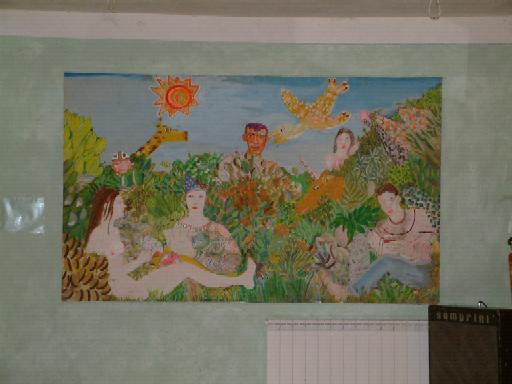
More imaginative decorations bring good cheer to the canteen where food is served next to the kitchen. Here the style is a bit more surrealist, with Eleonora Albanese's series of acrylics where a fork appears instead of a character's fingers or in other similar positions, and with small installations representing Man Ray-style lips or the tarot series.
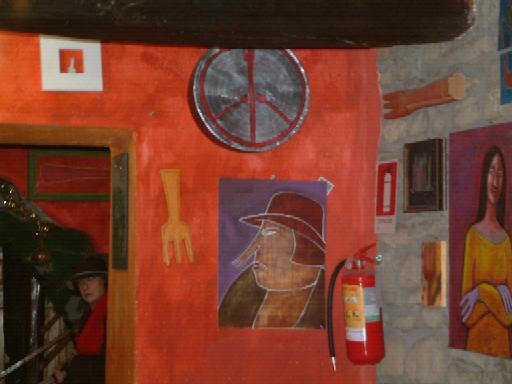
Also, the mouth of the fireplace is turned into a dog's open muzzle by the mural decoration around it. In the summer, the outdoor meadow area serves as a place for guests to meet and for informal activities with its garden chairs and hammocks.
[21] Guests leave their shoes outside the wooden-floor palestra, or gym, which functions as a multi-purpose activity room. Yoga for Airheads includes a variety of activities. Its structure reflects the influences of lateral thinkers who challenged the mainstays of conventional psychoanalysis, including Guattari and Deleuze, who, in their joint studies of capitalism and schizophrenia, invoke rhizomes as models for their sideways thinking as opposed to erect trees which represent state-approved philosophical systems (Massumi, 5). As in other workshops with elements of group therapy, the central idea is that a collectivity is more than the sum of its individuals due to similar marks in the inner landscape of each person, and to the merging aural energies that shape the group. In looking past both Freud and even his successor Lacan, these workshops revisit the psychoanalytical thinking proposed by Wilhelm Reich, which anticipates Deleuze and Guattari's anti-Oedipal theories inasmuch as it takes the focus away from the family. They also inscribe Roberto Assagioli integration of Eastern philosophical principles within psychoanalytical discourse.
3. Psychotherapeutic Legacies
[22] Respectively, Freud and Jung established the idea of an individual and a collective unconscious. But they never agreed on how the individual and the collective interact and complement each other. Wilhelm Reich, from the Freudian left, and Roberto Assagioli, who may be described as a voice from the Jungian left, contributed to this integration by challenging the paradigm on which Freudian and Jungian psychoanalysis are respectively based. In instituting individual psychotherapy Freud implicitly assumed that psychoanalysis heals the body by healing the mind. The mind, corresponding to his universalized concept of the "reality principle," reins in the body see of the impulses of the pleasure principle. Many of today's healing-arts practitioners consider individual psychotherapy a normalizing system and dub Freudian therapy "the talking cure." Even as it is made of body, they claim, the mind is more reasonable than the body; hence the talking cure only helps individuals fit in the world as it is.
[23] In a very radical move for the 1950s, Reich reversed Freud's assumption by proposing to heal the body by causing a full expression of its repressed wishes and trust that the mind would heal too. His move resonates with Marcuse's argument that historicizes Freud's reality principle. As Marcuse explains, "various forms of domination ... result in various historical forms of the reality principle ... [indeed] repression will be different in scope and degree according to whether ... a market economy prevails or a planned economy ... private or collective property" (37). The vision of an intentional community serves as a principle to organize its biopolitics, which often includes shared property and resources, hence the possible convergence of reality and pleasure principles in the utopian space therein. Reich's "Orgone Theory" emphasized orgasm as the ultimate healing release (285-398). In his view, a repressed and hence asocial or unhappy individual suffers from body armor, an accrued rigidity of the physical system articulated in a series of blocks. To get past these blocks, the structure of a person's socially-formed character must be broken down until a semi-vegetative, worm-like state is reached (372). At that point the healing organic energy is unleashed.
[24] Reich's theories became influential in the 1960s, at which time many groups who practiced his principles ran into violent conflicts and problems ensuing from each individual's desire to actualize the impulses of his or her id. This emphasis on the pleasure principle was not supported by a biopolitics conducive of a community-oriented reality principle. Compounded with Reich's own mental imbalance, this discredited his ideas. However, in utopian spaces where elements of group therapy are used to experiment with the creation of the possible new worlds auspicated by the global peace and justice movement, some application of Reich's theories is useful. The armor is the place where the body stores it unprocessed grief. And gestalt therapy, with its deep — sometimes violent — impact on the system is designed to remove it. In today's healing-arts and holistic-health movement, body-workers around the globe have taken up Reich's proposal to intervene on the body and its blocks. They perceive these blocks as active at the cellular lever and located in areas corresponding to the Hindu Chakra system, with the most important one located in the solar plexus area.
4. Styles of Bodywork
[25] Bodywork that helps dissipate this armor includes forms of individual massage and healing touch in which the therapist is the giver and the patient the receiver; more interactive bodywork styles in which participants in a group work on one another and vice versa; and various forms of biofeedback that enable regression to a pre body-armor past. Hence, by reversing Freud's mind/body order, Reich's move empowered today's healing arts practitioners and placed individual psychotherapy on the backburner. In Yoga for Airheads, the body armors of group participants dissolve under the healing touch of fellow participants. The group gets more in touch with subconscious desires as each singularity in it finds respectful and considerate ways to act on them. The day ends with a watsu session in chest-high, body-temperature water, where participants cradle and lull each other while the water massages their bodies. This regression to infant or prenatal life mollifies body armors and prepares for the overcoming of blocks and taboos.
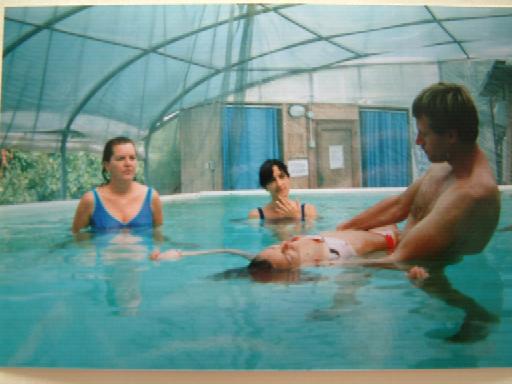
As the body heals the mind heals too but becomes more aware of the repressive systems and taboos that had caused the armors to begin with.The group and each singularity in it want to transform these taboos instead of being normalized to them.
[26] Assagioli's theory is helpful in understanding how
group therapy in
[27] The structure of Yoga for Airheads is paradoxical too, inasmuch as Jacopo Fo's lezioni, or lectures, argue against versions of the traditional "talking cure" while they are the most traditional part of the course — mostly requiring mental participation.
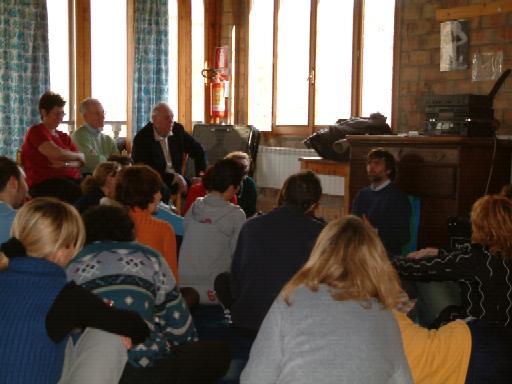
The contents of these lectures are also accessible in his books. Zen e l'arte di scopare, or Zen and the art of having good sex, focuses on aspects of one's amorous and/or sexual erotic life, while Come diventare dio in dieci mosse, or how to turn into a god in ten moves, focuses on aspects of practical life and well being. Both integrate thinking from Zen Buddhism and the Chinese martial art of Tai-Chi, as Fo insists that beyond the surface things are surprisingly simple and that meditative exercise empowers one to see this. Fo's central idea of pensiero laterale, or sideways thinking, has an affinity with Deleuzian rhizomes, which unlike upwardly developing trees and their downward roots, also expand sideways and form networks that enable communities to bring down the powers that lord over them. [xvi] Fo insists that by emphasizing the context of a target problem rather than the problem itself, lateral thinking produces holistic solutions that resolve the problem by transforming the context from which is arises. This of course refers to the line of holistic thinking developed by psychoanalytical theorists like Gregory Bateson in the US, R.D. Laing, Felix Guattari in France, and Franco Basaglia in Italy. [xvii] The practical solution Fo proposes include a healthy skepticism and sense of humor that help see through power systems and get beyond their intimidating tactics; an interest for nutritional solutions to health problems; and a willingness to experiment with awareness-enhancing techniques that involve various degrees of body interaction with other participants. The paradox of Fo's Diventare dio is that instructions on how to become god-like come from a person who rejects organized religion, which empowers participants while demystifying the whole idea of monotheism.
[28] In the sexual and amorous aspects of life, Fo applies sideways thinking too. The central idea is that the art of loving can be learned, and learning it is both ecologically sound and in everyone's best interest, because people with a happy amorous life tend to be more gentle with others and respectful of environmental resources. Fo claims that one's capability for happiness in amorous relationships is proportional to one's awareness of one's own multiple potential for pleasure and those of one's partners. For men this means getting past the premature ejaculation and quickies that alienate so many women, and be empowered to explore their own multiple pleasures, including L-spot pleasure and anal pleasure. Also for men, this means exploring relationships with older women who are aware of their pleasures and can be good love teachers. According to Fo, male frigidity is very common as many men ejaculate without orgasm, and are strangers to penetrative pleasures. Fo empowers women as teachers, who don't suffer from premature ejaculation, and can explore their own pleasures with more tranquility, including clitoral, anal, vaginal, and G-spot pleasures, as well as the less known female ejaculation. Unlike Reich, Fo does not emphasize orgasm tout court, but rather the shared and consensual fruition of multiple pleasures between men and women. He has much respect for what he calls "downstream" orgasms which couples advanced in the art of lovemaking can share together, and which imply a long prelude where a tantric plateau of ecstasy is shared. While Fo does not recommend bisexual, polyamorous, or in other ways queer experiences, his idea of pleasure is rather inclusive and certainly challenging to most conventional concepts of masculinity and femininity. The emphasis on opposite-gender partners reflects the squeamishness most Italians still have in identifying as bis or queers, even in alternative social circles and it speaks of a social context where non-heteronormative practices are common but are not discussed openly and freely.
[29] The rough and tumble games facilitated by Eleonora Albanese and others are designed to amalgamate the group and mollify the body armor of individual participants. In tapis roulant participants sit on the floor in a row, with their legs extended sideways. Their hands up form a rolling rug, as the first person in the row gets up and lies down on them, with a facilitator on each side for safety. As the participant is moved to the end of the row by hands rolling on his or her backside, the next in line begins. Body armor is mollified by the game's tossing and pushing about. Capoeira is a dance/wrestling game from Brazil. It was allegedly invented by slaves with chained legs who wanted to feel alive and learned to play with each other this way. It consists of various body-against-body moves in which one player lifts a leg to kick and the other ducks the blow under it. This game kindles participants' familiarity with unusual body parts and positions. The integration of a third-world trope corresponds to a desire to reflect the multiculturalism of today's Italy, a destination of many immigrants from the world's most impoverished regions. [xviii] Indeed, the diversity of today's Italian society is reflected in the Alcatraz facilitators pool, which often includes immigrants from non-European Union countries, while is it less evident in its guest participants. In vagina urlante, or screaming vagina, participants sit on the floor in two facing rows, their arms and legs forming a birth-channel-shaped tunnel.
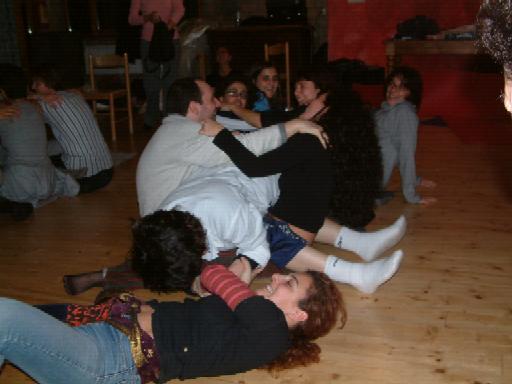
Facilitators help each person at the beginning of the tunnel enter it and come out at the other end. Again, tossing from side to side mollifies bodies and amalgamates the group.
[30] Other rough and tumble games involve jumping, running, and dancing, with blindfolding sometimes used to enhance touch in games that involve hugging or stroking. Also included are classes in the rudimentary principles of martial arts and beginning tai-chi; spontaneous and improvised art production on white paper and acrylic; and the giving and receiving of applause. The bambola massage, and the watsu classes are especially conducive of regressions to a pre-body armor state. The first is practiced in the activity room, in a special candle-light atmosphere, where five people practice healing touch on a person's hands, head, and feet, facilitating a light hypnotic state. The watsu style practiced at Alcatraz is said to trigger memories from life in the womb and, according to some, from previous lives too. It was developed by holistic health facilitator Harold Dale at the intentional community center of Harbin Hot Springs, in California. In Yoga for Airheads, it is a daily complement to the other activities, with its rudiments taught to participants who practice on each other. The games' bodily activity interacts with the Fo lessons' intellectual stimulation, as the two integrate to break up participants' conventional thinking, mollify their body armor, and enhance their awareness.
5. Culinary Pleasure Principles
[31] Much in line with Marcuse's famous challenge to Freud's
surrender to the reality principle, the art of challenging with pleasure is
practiced in the
[32] The
[33] Furthermore, the menu of entrees and side dishes
proposed by the
Texts
1. A Community's Biopolitics
[34]
The
[35]
The book opens by pointing to the deep and condoned ignorance about
[36] Gesù amava le donne e non era biondo, or Jesus loved women and was not a blond, uses information from the apocryphal Gospels to humanize Jesus and debunk Roman Catholic dogmas like the immaculate conception and the celibacy of priests. The apocryphal Gospels, the book claims, have been declared false because, if it was better known that Jesus had brothers and sisters, people would no longer believe that his mother was a virgin (27-31, 67-71, and passim). If people also knew that Magdalena was his lover and that he loved women, the celibacy vows Catholic priests are forced to take would sound ridiculous too (56-57, and passim). The book situates early Christianity in the context of the Orphic mysteries and their legacy from the Neolithic Goddess religion, and traces back the gradual exclusion of the feminine from the sacred that occurred as Christianity consolidated as an organized, monotheistic religion (31-34, 57-95, and passim). [xix] By placing Jesus' personal story in the context of the early Roman Empire and the new spiritualities that sustained its rebellious multitudes, the book offers tools for change to activists in today's Christian cultures too.
2. Embodied Gender and Women
[37] Sulla naturale superiorità della donna, or on the natural superiority of women, is a multi-author book that unabashedly celebrates women's cultural and biological differences from men as that which proves them superior in the ability to think and act holistically, even as it lists the forms of oppression women have endured in many ancient and modern cultures. The embodied sense of gender that emanates from this position reflects the Italian feminist tradition of sessuazione, a biopolitical concept of gender that emphasizes its intimacy with embodiment. More than one Anglo-American feminist theorist from the second wave generation cringed at this intimacy, due to the legacy of squeamishness about the body in that cultural tradition, even as Anglophone Italian theorists like Rosi Braidotti and Teresa de Lauretis rushed to explain that sessuazione's alleged essentialism was only strategic. [xx] The authors of Sulla naturale, including Fo, his editor Gabriella Canova, and other collaborators, bank on the paradigm established by that strategic essentialism to claim that women
think in global terms. [Their] vision of things embraces, contains, envelopes, a situation as a whole. For women, there are no individual difficulties, individual moments, but a continuous flux, a constant effort to overcome a current's resistance. (La donna pensa in termini globali. La sua visione delle cose abbraccia, contiene, prende, l'insieme delle situazioni. Per la donna, non esistono singole difficoltà, singoli momenti ma un fluire continuo, uno sforzo costante per superare la resistenza della corrente [26, my translation].)
Evidence for this alleged superiority, the authors claim, comes from the study of matriarchal civilizations of the Neolithic, which were peaceful, worshipped feminine principles, and considered lovemaking a sacrament. Prehistory teaches a different story from history. Since the onset of male dominance about 10,000 years ago, the authors claim, violence has increased because men think with their penis,
They see anything as an object to be penetrated. Be it a woman or a commercial enterprise, men see only one thing at a time. Men isolate issues and try to sneak inside them by breaking every resistance. (Egli vede in tutto qualcosa da penetrare. Si tratti di una donna o un'impresa commerciale egli vede solo una cosa per volta. Isola le questioni e cerca di infilarcisi dentro vincendo ogni resistenza [26, my translation].)
Aware of their biological and cultural inferiority to women, men have incessantly tried to hide this by demonstrating their superiority in oppressive and violent ways, and then they've called this horrific story history. The authors conclude that we need more "thinking from the pussy" ("ragionare... con la pisella") because "humanity's life must be healed as a whole, just like a sick infant, with patience, dedication, and love, just like women do." ("La vita dell'umanità va curata tutta assieme, come un neonato ammalato. Con pazienza, dedizione e amore.Proprio come fanno le donne" [27, my translation].) This celebration of the healing powers of femininity resonates with the Gaian awareness and holistic thinking that animate the global peace and justice movement. The book is also visually interesting as it displays the affinities between soft female shapes like a woman's round tits with architectural symbols like the twin domes typical of early modern Italy (56-57).

This passage to the symbolic, in a feminist/feminine style, is a healthy antidote to Lacan's insistence on the association between the symbolic and the phallic symbols. In a mock s/m tone, the cover shows a playful dominatrix, well formed and in the nude, riding a somewhat scrawny man on all four, also in the nude, with her hands holding the reins he bites in. The picture, Fo style, symbolizes the Gaian order in which phallic energy is marshaled in to accomplish an all-embracing, feminist femininity.
[38] The >Alcatraz books also display the various ways in which Fo and his collaborators work together. For example, Fo appears as sole author for Diventare dio and Lo Zen e l'arte di scopare, which clearly are emanations from his Yoga for Airheads lessons. Due to its size, detail, and depth of argumentation, Schiave ribelli requires the kind of serious scholarly apparatus that from his base in Alcatraz Fo is non likely to be able to put together. Here the authorship is shared equally with his collaborator and research assistant Laura Malucelli. Similarly, Gesù amava le donne is coauthored with Malucelli and offers appendixes that document its claims. Sulla naturale suepriorità della donna is a more popularizing type of book intended to challenge the last resistance of macho types on their way to redemption by mocking them and amusing them. The authorship here is multiple, with three authors besides Fo, and with Gabriella Canova using the first person in some pages of the book. Finally, La grande truffa delle piramidi, the book I will discuss in most detail due to the interest of its theory, is by Fo alone, whish reflects his wish to take on himself the entire risk of its rather far fetched conclusions.
3. Let Water Do All the Work!
[39]
La grande truffa begins by
dismantling belief systems that are commonly accepted but detrimental to the
possibility of creating the new possible world we need. For example, Fo claims that what we believe
about the Pyramids is absurd, for it implies that an entire people, the
Egyptians, invested the majority of their energy in building immense graves. According to Fo, this paradox flags some
political distortion, and he intends to challenge the established idea. Another established idea around pyramids is
that to build them in the era before fuel-burning technology slave labor must
have been used. This idea causes people
to believe that a world with less pollution will require more slave labor,
whereas the fact is that corporate globalization produces both slavery and
pollution. Fo wishes to dismantle this
belief-system, so that
[40] Based on his lateral, rhizomatic method of thinking, he compares the pyramids in Egypt to those in Colombia, Mexico, and Nubia, all of which are shaped like Mastabas, or pyramids with a flat top — like the one with a flipped tip on the book's cover.
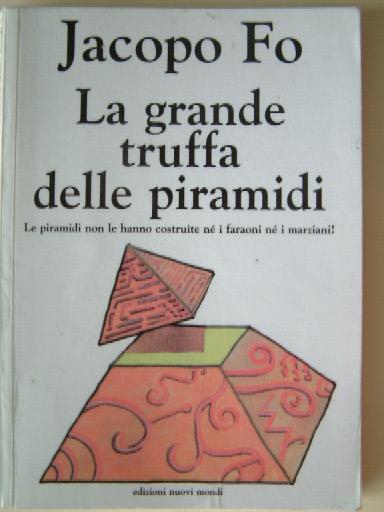
He also observes that Egyptologists have been puzzled by the signs of water erosion on the Sphinx, which is right next to the so-called big mausoleums of the three pharaohs Cheops, Chephren and Mycerinus. This erosion indicates a possible construction date in prehistory. At this point Fo advances the hypothesis that the bases of these three major pyramids might have been built by the black matriarchal agricultural civilizations of the Neolithic during the Subpluvial Period, namely between 15,000 and 10,000 B.C., and in any event way before the invasions of white warrior-shepherds, which, around 4,500 B.C., gave rise to patriarchal history. Several practical reasons corroborate this hypothesis which archeologists have never completely ruled out (22-48).
[41] The matriarchal civilizations of the Neolithic did not worship death and therefore would have had no use for big mausoleums; they were agricultural and formed by black people. However, they were very advanced in their management of waters, since agriculture and hydraulic systems were their mainstay. The mastabas or flat pyramids provided an elevated space when the Nile flooded, and functioned as water condensers in drought periods.
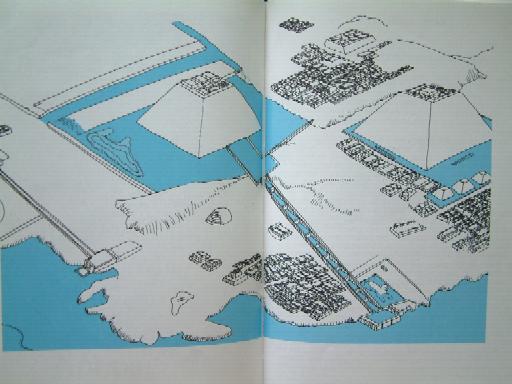
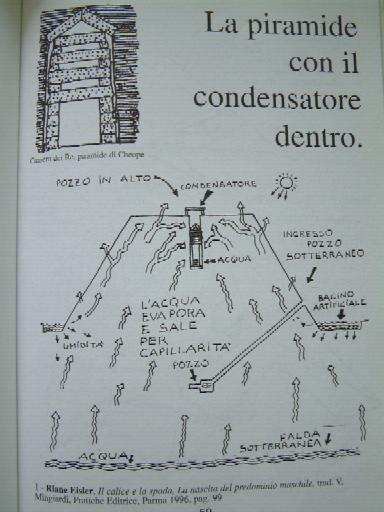
Therefore, they had plausible uses in both flood and drought times (49-64). This surmise encourages Fo to inquire further into the possibility of using a pyramid for condensing water. Even today, he claims, desert people like the Berbers arrange stones in small heaps so that, when the desert wind traverses them, its little moisture condenses into water due to the lower temperature inside the heap. The flat pyramids, Fo claims, could have been a much bigger version of these heaps (77-86).
[42] The implications of this hypothesis are significant. They include a valorization of the black matriarchal agricultural civilizations of the Neolithic, which had no war, were egalitarian, holistic, and also had remarkable hydraulic technology and high land-stewardship and ecological management skills. The interest of studying these civilizations in a time of water wars and alleged scarcity of resources prompts a reconfiguration of the boundary between history and prehistory, with the mark placed not at the onset of literacy but at the onset of advanced water managements and hydraulic technologies. [xxi] Finally, it includes the implication that black and not white people built the pyramids, thus confirming Fo's claim that people of color are often denied credit for their contributions. This rhetorical strategy short-circuits the political correctness of neo-liberal inclusiveness, as it confers superior stature to those conventionally considered inferior and more primitive.
[43] There is a hopeful message in the idea that the pyramids were built not to worship death but rather to create more stability in the lives of Neolithic communities. Fo goes even further in drawing a philosophical conclusion that is consonant with the intent of the Alcatraz community and the global peace and justice movement. For people in the Neolithic communities, he claims, "God was a glass of water" (74). Water is a life-enhancing liquid that resembles the amniotic liquid in which each human develops. It is a source of life, and the basis for the biosphere, atmosphere, and biota, as well as the element in which the first forms of life developed. The respect Neolithic communities had for it proves that perhaps their knowledge was superior to that of their patriarchal successors. This encourages Fo to think that perhaps Neolithic communities even knew how to get mastabas built with a reasonable amount of labor. He then moves to address the constructed dichotomy between slave labor and fuel-engine pollution. As he explains, Neolithic communities had advanced water management skills, and they could have developed a system of water elevators and floaters placed around the big stones used to build the mastabas. These water elevators would have looked like water pits in the middle of the structure to be built, connected with a tunnel water channel at the mastaba's base. Stones would have been equipped with inflated floaters made of animal skin, and, placed in the elevator, they would automatically have risen the top of the pit. From there, they would have been manually placed in the correct position, and so on and so forth until the mastaba was completed.
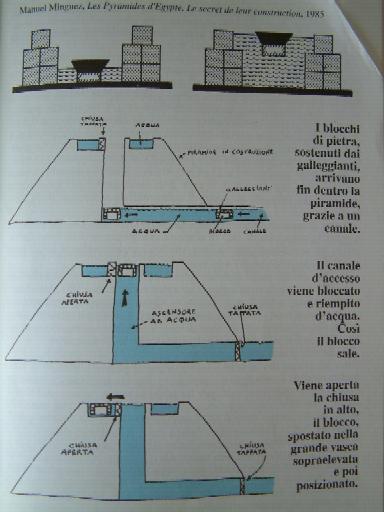
[44] This method of construction, Fo claims, is more consonant with the philosophy of egalitarian Neolithic communities, than slave labor is. And, as Fo presents it, the elevator system would have required equipment within their reach. Fo wonders why more specialized Egyptologists have not investigated this hypothesis seriously, and suggests that their belief system might have stopped them from formulating this hypothesis to begin with. This proves the point that to think out of the box one has to step out of the system. We need to look at the past with fresh eyes if we wish to invent a new future. To those who claim that pollution is a modern necessity, Fo responds that, if primitives in the Neolithic knew how to make water do all the work, so certainly can we.
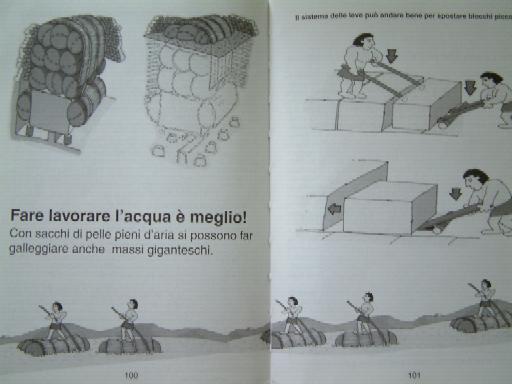
Fo suggests that in order to reinvent these lost skills, we stop focusing on what has been heretofore called history and should actually be called cronaca nera, or crime news. Indeed, in the wider perspective that includes the Neolithic and its black matriarchal hydraulic civilizations, the period we call history, from about 4,500 B.C. to our days, is but a saddening laundry list of wars, dynasties, rivalries, and devastations. The knowledge we need lies back with those civilizations that have been dismissed as "black," "matriarchal," and "primitive." "Another world is possible," says the global justice movement. The call to action resonates with Alcatraz and Fo answers, "let's find out how by revisiting prehistory!"
Conclusion
[45] Intentional communities and the holistic organizations that work with them can be seen as utopian laboratories for the other possible worlds envisaged by the global peace and justice movement, especially those that focus on ecologically aware, alternative biopolitics. One such organization and community is Alcatraz in central Italy, whose belief-system, activities, and books design a coherent biopolitical alternative vision. Intentional communities and holistic organizations are produced by the flows of deterritorialization and reterritorialization that result from corporate globalization processes. But they redirect that flow towards higher plateaus of energy where an enhanced Gaian awareness encourages the development of a biopolitics configured as if the planet was a organism with a life of its own, and with the ability of ridding itself of overdeveloped species like humans. Holistic organizations develop utopian tools, often in the form of workshops where kinesthetic styles of learning serve to teach guest participants how to reprogram themselves for the other possible worlds they wish to invent as participants in the global peace and justice movement. Alcatraz's workshop, Yoga for Airheads, is a case in point as it teaches practices of the body that allow participants to engage with their health and love lives more deeply and to reconnect with their suppressed pleasure principle in generous and considerate ways.
[46] Holistic organizations are sometimes also organized as schools of thought that produce their own texts embodying their independent research and the ensuing belief systems.The Alcatraz books on women's alleged superiority, Sulla naturale... and on the origin of pyramids, La grande truffa..., represent this genre interestingly. The first advocates the superiority of "thinking from the pussy" based on its encompassing holism, while it deprecates the more canonical "thinking from the penis," which is too divisive and analytical. It also claims that this mode of thinking makes women superior, despite men's pathetic efforts throughout history to ever demonstrate a superiority which still stands unproven. The second book proposes that to invent a new future we learn from prehistory, and in particular from the black matriarchies of the Neolithic which worshipped water, had no war, and invented complex hydraulic technologies like the ones probably used to build the base of the Egyptian pyramids. Alcatraz claims that patriarchal history is "crime news," a string of conquests, wars, and genocides that can hardly be used as a model for the sustainable, eco-friendly, and symbiotic new styles of development we need. Water, with its ubiquitousness and fluidity, is a paradigm for the kind of resources Gaia's guests, including humans, need to share if we still want our hostess planet to have room for us on its mantle teeming with life. Sharing resources creates abundance and enables communities to accomplish a lot without excessive toil, as did, in the hypothesis advanced by Alcatraz, the matriarchal workers of the Neolithic, who simply "allowed water to do all the work." Antonio Negri and Michael Hardt claim that today's multitudes are rendered abject by the empire with no outside of the one-superpower system. If we look again at matriarchal prehistory and are humble enough to learn from it, Alcatraz and other intentional communities claim, the other possible worlds these multitudes envisage might become real.
Notes
[i] Starhawk's Webs of Power is a report from the field of her participation in and training for the movement. It offers detailed accounts of how these groups are organized as "distributed networks" that, as Antonio Negri and Michael Hardt have suggested, have "swarm intelligence." For Latino slogans see Starhawk, 25-26; for Hardt and Negri's points see Multitude, 54-59, 93-94, and passim. Another useful source is Collettivo Malatempora, Movimento: da dove viene, cos'è, cosa vuole, cosa farà.
[ii] The idea of utopian tools or utopian machines comes from classical Marxist utopian theory. Here it is applied to tools of inner transformations such as workshops and other participatory events and rituals hosted by holistic organizations and intentional communities. For a discussion of utopian tools in a postmodern context, I refer to "Postmodern Utopianism: Deleuze and Guattari and the Escape from Politics," a paper by Millay Hyatt at the 5th annual meeting of the Utopian Studies Society in Porto, Portugal, July 2004.
[iii] A comprehensive listing of intentional communities is available online thanks to FIC, the Fellowship for Intentional Communities, «http://directory.ic.org/geo/». Holistic organizations include study and/or retreat centers and/or practice groups whose core members share holistic visions and are committed to actualizing them together. They may have their own base and their activities may be hosted by the facilities of other communities.
[iv] I refer to the joint work of the philosopher and psychotherapist in the books Anti-Oedipus and A Thousand Plateaus, both of which are subtitled Capitalism and Schizophrenia, as well as to the illuminating discussions of them presented by Brian Massumi in A User's Guide to Capitalism and Schizophrenia; by Slavoj Žižek in Organs Without Bodies: On Deleuze and Consequences, and by Claire Colebrook in Gilles Deleuze. Massumi, Colebrook, and Žižek.
[v] Deleuze and Guattari discuss fluxes of deterritorializations and reterritorializations within the capitalist system in Anti-Oedipus, Section 2/9 and 4/9-10 (130-138, 220-261), and passim. Even though Deleuze and Guattari's collaborative work dates back to the 1970s, these tropes apply very productively to the demographic movements of the globalization era. More on today's relevance of the two collaborators' treatment of capitalism and schizophrenia Brian Massumi, A User's Guide to Capitalism and Schizophrenia, Slavoj Žižek, Organs Without Bodies: On Deleuze and Consequences, and Claire Colebrook, Gilles Deleuze.
[vi] This aspect of the movement is especially well described by Starhawk's Webs of Power. She is a participant and organizer in the movement, a leader in the new-spirituality movement, a practitioner of permaculture and other eco-regenerative agricultural systems, and a participant and founder in numerous holistic and intentional communities. Also important is Alternatives to Economic Globalization: A Better World is Possible.
[vii] In Deleuze and Guattari's initial formulation, deterritorializations have a revolutionary potential, while reterritorializations are generally conservative, and can even be connoted as despotic and fascist. I disagree, and, in view of today's higher concern with environmental issues, I believe these authors would acknowledge that a sense of place is necessary as a basis for community--even as, as singularities, we continue in our nomadic existences--so that the "multitude's swarm intelligence" Hardt and Negri celebrate in Multitude can also generate good land stewardship. The recent scholarship by Walter Mignolo on transculturation in early modern history and its relations to Gnosticism and other unorthodox ideas also moves in this direction.
[viii] For the concept of empire as the emerging configuration in the post-Cold-War period, I refer to Antonio Negri and Michael Hardt's Empire, which claims that the one-superpower system is empire, while the French, British, and even the Cold-War American colonial dominations were simply forms of "imperialism," namely a striving process to achieve seamless control. As they claim, though, this very achievement is the beginning of the end.
[ix] Classics on the Gaia Hypothesis are James Lovelock's Gaia: A New Look at Life on Earth, and The Ages of Gaia: a Biology of our Living Earth; Lynn Margulis's Symbiotic Planet: A New Look at Evolution; and Lynn Margulis and Dorion Sagan, Slanted Truths; Essays on Gaia, Symbiosis, and Evolution. Margulis and Lovelock's perspectives are complementary, and, one could even add, symbiotic. Margulis focuses on life's microcosms, like bacteria, cells, and symbionts, to conclude that the whole of the biota, with all its evolved organisms, can be considered a superorganism evolved by symbiosis. Lovelock focuses on life's macroscopic aspects, and notes that while Gaia's neighbors Mars and Venus look like logs, Gaia looks like a tree green with leaves. These are two different ages in these planets' respective lives. Lovelock warns that Gaia too could enter the log age if we continue to mess with it.
[x] Factual information about Auroville is available in the 2002 Almanac, Auroville, Universal Township. I also refer to the photographic and testimonial documentation I collected as a participant observer in my 2004 research trip, which has been presented at the October, 2004 CEA Conference, Caribbean Chapter, in Mayagüez, Puerto Rico.
[xi] I report information gathered through observation and interviews with community members, during my informal visit in July 2004. Tamera's website is at «http://www.tamera.org/english/».
[xii] The link to HAI's informative website is «http://www.hai.org/»
[xiii] The link to Landmark Education's rather complex website is «http://www.landmarkeducation.com/»
[xiv] The link to Alcatraz's informative website is «http://www.alcatraz.it»
[xv] My sources are a holographic interview with Jacopo Fo conducted in the summer of 2001, and an informal conversation with Franca Rame, whom I met again at Alcatraz on New Year's eve, 2003, some twenty years after my first extensive interview with her published in Feminist Issues in 1991.
[xvi] Deleuze and Guattari's theory of the rhizome is in Thousand Plateaus, 3-25 and passim.
[xvii] I refer to the perspectives on the content and impact of Deleuze and Guattari's work about capitalism and schizophrenia presented in Massumi and Colebrook's work.
[xviii] For more information on multiculturalism and immigration in Italy, see Pankiewicz, "The Problem of Immigration in Italy."
[xix] For more information on recent studies about female deities and the rise of monotheism see Lucchesi and Pistoso.
[xx] For more info on the debate about sessuazione and strategic essentialism I refer to Teresa de Lauretis, "The Essence of the Triangle, or Taking the Risk of Essentialism Seriously," and to Rosi Braidotti's "United States of Europe or United Colors of Benetton?" Another feminist theorist who has engaged the debate on strategic essentialism is Gayatri Spivak.
[xxi] About water as cause for conflict and about the privatization systems that cause water scarcity, see Vandana Shiva, Water Wars.
Works Cited
Anderlini-D'Onofrio, Serena. "Franca Rame: Her Life and Works." Theater: 17: 1: 32-39. 1985. Translated into Italian as "Franca Rame donna e attrice." Il Ponte: 65: 6: 99-110. 1990.
—. "From The Lady is to be Disposed of to An Open Couple: The Theater Partnership of Dario Fo and Franca Rame." Atenea: XX (1998): 3: 1 (31-52). Reprinted in Walter Valeri ed. Franca Rame: A Woman Onstage. West Lafayette, Indiana: Bordighera, 2000.
—. "When Is a Woman's Work Her Own? An Interview with Franca Rame." Feminist Issues 11 (1991) 1: 22-52.
Assagioli, Roberto. Psychosynthesis: A Collection of Basic Writings. Amherst, Mass.: The Synthesis Center, 2000.
Aurovile Foundation. Auroville, Universal Township. Auroville Press, 2002.
Bauval, Robert and Adrian Gilbert. Orion Mystery: Unlocking the Secrets of the Pyramids. New York: Crown, 1995.
Braidotti, Rosi. "United States of Europe or United Colors of Benetton?" Differences 2: 3 (Fall 1990): 109-21
Cavanagh, John and Jerry Mander, eds. Alternatives to Economic Globalization: A Better World is Possible. San Francisco: Berrett-Koehler Publishers, 2004.
Colebrook, Clare. Gilles Deleuze. New York: Routledge, 2002.
Collettivo Malatempora. Movimento: da dove viene, cos'è, cosa vuole, cosa farà. Rome: Malatempora, 2003.
De Lauretis, Teresa. "The Essence of the Triangle, or Taking the Risk of Essentialism Seriously." Differences 1: 3 (1989): 3-37.
Deleuze, Gilles, and Félix Guattari. A Thousand Plateaus: Capitalism and Schizophrenia. Tr. Brian Massumi. Minneapolis: University of Minnesota Press, 1987.
—. Anti-Oedipus: Capitalism and Schizophrenia. Tr. Robert Hurley. Minneapolis: University of Minnesota Press, 1983.
Fo, Jacopo. Diventare Dio in dieci mosse. Varese: Demetra, 1996.
—. Gesù amava le donne e non era biondo. Alcatraz: Nuovi Mondi, 2000.
—. Guarire ridendo. Milan: Mondadori, 1997.
—. La dimostrazione chimica dell'esistenza di dio. Alcatraz: Nuovi Mondi, 2000.
—. La grande truffa delle piramidi. Alcatraz: Nuovi Mondi, 1998.
—. Lo Zen e l'arte di scopare. Varese: Demetra, 1996.
Fo, Jacopo and Serena Anderlini'D'Onofrio. "Intervista." August 3, 2001. Holograph.
Fo, Jacopo, Garbiella Canova, M. Musicanti, and D. Triolo. Sulla naturale superioritá della donna. Varese: Demetra, 1994.
Fo, Jacopo, and Laura Malucelli. Schiave Ribelli: 500 anni di vittorie africane censurate dalla storia. Alcatraz: Nuovi Mondi, 2001.
Fo, Jacopo, Sergio Tomat and Laura Malucelli. Il libro nero del Cristianesimo. Alcatraz: Znuovi Mondi, 2000.
Foucault, Michel. The History of Sexuality, Vol. 1. Tr. Robert Hurley. New York: Vintage, 1990.
Gimbutas, Marija. The Language of the Goddess. New York: Thames and Hudson, 1989.
—. The Living Goddesses. Berkeley: University of California Press, 2001.
Hancock, Graham. Fingerprints of the Gods. With Santha Fajia photographer. New York: Random House, 1996.
—. Heaven's Mirror: Quest for the Lost Civilization, Vol. 1. With Santha Fajia photographer. New York: Crown, 1999.
Hardt, Michael, and Antonio Negri. Multitude: War and Democracy in the Age of Empire. New York: Penguin, 2004.
Hyatt, Millay. "Postmodern Utopianism: Deleuze and Guattari and the Escape from Politics." Paper at the 5th conference of the Utopian Studies Society (July 2004), Porto, Portugal.
Labellarte, Angela. La cucina leggendaria di Alcatraz. Alcatraz: Nuovi Mondi, 1995.
Lovelock, James. Gaia: A New Look at Life on Earth. Oxford University Press, 1982.
—. The Ages of Gaia: A Biography of Our Living Planet.< New York: Commonwealth Fund, 1988.
Lucchesi, Nadia. Frutto del ventre, frutto della mente: Maria madre del Cristianesimo. Ferrara, Tufani, 2002.
Marcuse, Herbert. Eros and Civilization: A Philosophical Inquiry into Freud. Boston, Beacon Press, 1966.
Margulis, Lynn. Symbiotic Planet: A New Look at Evolution. New York: Basic Books, 1998.
Margulis Lynn and Dorion Sagan eds. Slanted Truths: Essays on Gaia, Symbiosis, and Evolution. New York: Copernicus, 1997.
Massumi, Brian. Deviations from Deleuze and Guattari: A Users' Guide to Capitalism and Schizophrenia. Cambridge, Mass.: The MIT Press, 1992.
Mignolo, Walter. Local Histories/Global Designs: Coloniality, Subaltern Knowledges, and Border Thinking. Princeton University Press, 2000.
Pankiewicz, Flavia. "The Problem of Immigration in Italy." Differentia 8-9 (Spring/Autumn 1999): 47-56.
Shiva, Vandana. Water Wars: Privatization, Pollution, and Profit. Cambridge, Mass.: South End Press, 2002.
Starhawk. Webs of Power: Notes from the Global Uprising. Gabriola Island, Canada: New Society Publishing, 2002.
Pistoso, Giuliana. Erodiade e Gesù. Ferrara, Tufani, 1998.
Žižek, Slavoj. Organs without Bodies: On Deleuze and Consequences. New York, Routledge, 2004.
Web Resources
Alcatraz home page, «http://www.alcatraz.it»
FIC, Fellowship for Intentional Communities, «http://directory.ic.org/geo/».
Human Awareness Institute home page. «http://www.hai.org/»
Landmark Education home page. «http://www.landmarkeducation.com/index.jsp?top=20»
Werner Erhard and EST — the Rick Ross Institute «http://www.rickross.com/groups/est.html»
